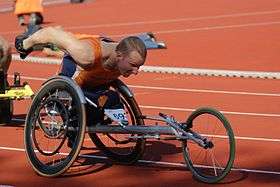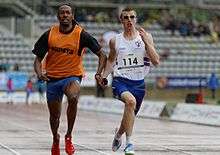Paralympic athletics

Paralympic athletics is a disabled sport practiced by athletes with a physical disability who have competed at separate international events since 1952. It is governed by the International Paralympic Committee through its World Para Athletics subcommittee, and has been one of the sports at the Summer Paralympic Games since 1960.[1][2]
Rules for the sport are adapted from those set forth by the International Association of Athletics Federations (IAAF). The majority of rules for Paralympic athletics are the same as those for able-bodied competitions.
Classification

Competitors at elite level competitions are classified by disability, to arrange athletes with a similar disability in the same event. A classified T12 athlete for example, is a track athlete with a visual impairment.
- F = Field athletes
- T = Track athletes
- 11–13 – Visual impairment. Compete with a sighted guide.
- 20 – Intellectual disability
- 31–38 – Cerebral palsy
- 41–46 – Amputation, and others (including athletes with dwarfism)
- 51–58 – Wheelchair
In wheelchair racing, athletes compete in lightweight racing chairs. Most major marathons have wheelchair divisions and the elite racers consistently beat the runners on foot.
Events
Paralympic athletes compete in the following events. Note that not all events may feature at a particular tournament, and not all events may be open to all classifications:
See also
References
- ↑ Para- Athletics – History Archived 2012-05-31 at the Wayback Machine., Athletics Canada
- ↑ About the Sport Archived 2012-06-25 at the Wayback Machine., IPC Athletics
External links
- Paralympic athletics at IPC web site
